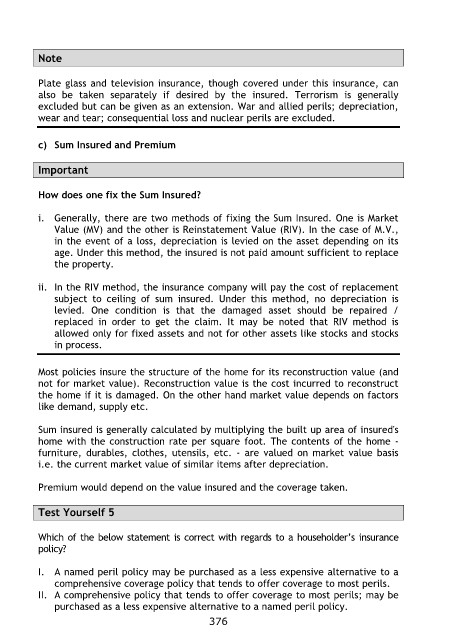Page 382 - IC38 GENERAL INSURANCE
P. 382
Note
Plate glass and television insurance, though covered under this insurance, can
also be taken separately if desired by the insured. Terrorism is generally
excluded but can be given as an extension. War and allied perils; depreciation,
wear and tear; consequential loss and nuclear perils are excluded.
c) Sum Insured and Premium
Important
How does one fix the Sum Insured?
i. Generally, there are two methods of fixing the Sum Insured. One is Market
Value (MV) and the other is Reinstatement Value (RIV). In the case of M.V.,
in the event of a loss, depreciation is levied on the asset depending on its
age. Under this method, the insured is not paid amount sufficient to replace
the property.
ii. In the RIV method, the insurance company will pay the cost of replacement
subject to ceiling of sum insured. Under this method, no depreciation is
levied. One condition is that the damaged asset should be repaired /
replaced in order to get the claim. It may be noted that RIV method is
allowed only for fixed assets and not for other assets like stocks and stocks
in process.
Most policies insure the structure of the home for its reconstruction value (and
not for market value). Reconstruction value is the cost incurred to reconstruct
the home if it is damaged. On the other hand market value depends on factors
like demand, supply etc.
Sum insured is generally calculated by multiplying the built up area of insured's
home with the construction rate per square foot. The contents of the home -
furniture, durables, clothes, utensils, etc. - are valued on market value basis
i.e. the current market value of similar items after depreciation.
Premium would depend on the value insured and the coverage taken.
Test Yourself 5
Which of the below statement is correct with regards to a householder‟s insurance
policy?
I. A named peril policy may be purchased as a less expensive alternative to a
comprehensive coverage policy that tends to offer coverage to most perils.
II. A comprehensive policy that tends to offer coverage to most perils; may be
purchased as a less expensive alternative to a named peril policy.
376

